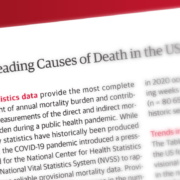I’m Alive V2.56
When I woke up this morning, I knew I had another year to do what I do but with more urgency. If you want to know the story, read last year’s Memo to understand. Why more urgency? Simple: I’m not any younger and while I try to age with a vengeance, the clock keeps ticking and I’ve got a lot to do. Let’s get to it.
My foray into the primary or secondary cause of death stems from a variety of sources: my once-favorite statistician, a comic, self-proclaimed gurus, and many healthcare professionals who should know better. I’m going to try to set things straight with a few examples.
The Cold
Q. Someone has a really bad cold, but a light bulb has gone out and he must get on a ladder to change it. While up on top, he sneezes, falls off the ladder, hits his head, and dies. What is the cause of death?
A. Was it the cold? The light bulb? The ladder? None of those—he died from a fall. Without those first three factors, there would have been no fall, and he’d still be miserably dealing with cold symptoms.
The Car Accident
Q. Let’s say someone is a type 2 diabetic. She is obese, has high blood pressure, and has been diagnosed with cardiovascular disease. She has a car accident; she is severely injured, loses a lot of blood, and while on the way to the hospital, she has a myocardial infarction and dies in the ambulance. What is the cause of death?
A. The loss of blood due to injuries in the car accident. The CVD may be a contributing factor, but with no accident and no blood loss, she won’t die on that day.
The Respiratory Infection
Q. Let’s keep the same person for this scenario only in this case, she catches a respiratory viral infection like the flu or respiratory syncytial virus (RSV), which has been in the news lately. She gets severe symptoms including congestion that require hospitalization. She continues to get worse, has a heart attack, and dies. What is the cause of death?
A. The cause of death is the viral infection. The obesity, the hypertension, the diabetes, and the CVD could have been contributing factors, but again, no infection and she’s still alive. You may be surprised that 6,000–10,000 people per year with CVD die due to RSV this way each year.
More
The rantings of the people I mentioned earlier shouting, “They died of their lifestyle, not of an infection!” is simply wrong. The presence of the pre-existing conditions might kill them in the next 5, 10, or 30 years, but they’d been living with those conditions for some time, and there’s no reason to think they would have died on that particular day—no infection, no death at that time. It was the infection that caused their death.
The Bottom Line
We live in a world where social media and purported health gurus overshadow science, and sometimes, common sense. There are plenty of gray areas in the interpretation of health information. Yes, we should all do better to improve every facet of our health, but we should not change the interpretation of causes of death to fit a specific narrative. That can harm us all because it may raise doubt about preventive steps we can take. In the end, it’s your body and your choice. Choose wisely.
What are you prepared to do today?
Dr. Chet
References:
1. https://doi.org/10.1111/imj.13377
2. Biomedicines 2023. 11:71






